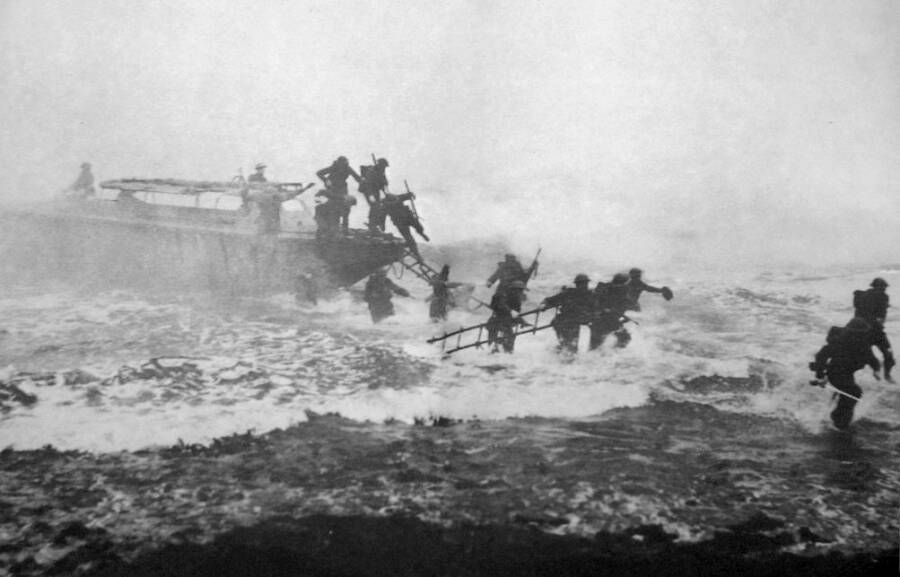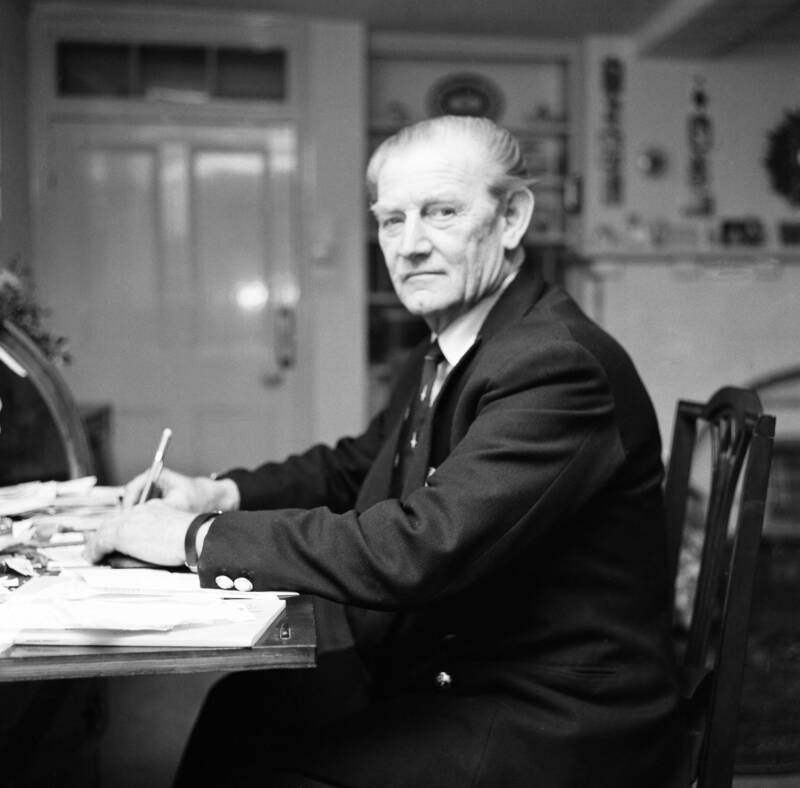Fond of playing his bagpipes before charging into battle with his broadsword and longbow in hand, Lt. Col. "Fighting Jack" Churchill was a soldier unlike any other.

Sunday People/Mirrorpix/Mirrorpix via Getty ImagesLieutenant Colonel John Malcolm Thorpe Fleming Churchill — a.k.a. Jack Churchill, “Fighting Jack” Churchill, and “Mad Jack” Churchill — a British soldier who fought throughout World War II armed with a longbow, arrows, and a Scottish broadsword.
Lieutenant Colonel John “Mad Jack” Churchill had a motto: “Any officer who goes into action without his sword is improperly dressed.”
He was referring, of course, to the basket-hilted Scottish broadsword he armed himself with during battle — and no, Mad Jack Churchill was not a Viking warrior or a medieval knight.
He was an officer in the British Army during World War II who famously wielded archaic weaponry, a longbow, and a sword, at the same time the world was first introduced to the horrendous power of atomic weaponry. Fighting Jack Churchill also carried a bagpipe with him, a talent for which he had previously shown off in a number of films.
And despite his eccentricities, Jack Churchill proved himself to be a more than capable fighter, escaping capture twice, earning recognition for killing enemy soldiers with a bow, and capturing 42 German soldiers alongside a Corporal — while Churchill was armed with just his sword.
Jack Churchill’s Life Before The Second World War
John Malcolm Thorpe Fleming Churchill, better known as Jack Churchill, was born in 1906 in Hong Kong, where his father, Alec, had been appointed the Director of Public Works. Following the appointment, the family moved with him to Asia, where they lived until 1917.
During this time, the young Churchill got his first taste of adventure, often exploring the rural areas around the city. When his family moved back to their native England, his desire to explore did not fade.

Daily Mirror/Mirrorpix/Mirrorpix via Getty ImagesJack Churchill once ran onto the battlefield playing his bagpipes and lobbying grenades at enemy soldiers.
According to Historic UK, Churchill then entered the Royal Military College in Sandhurst, and graduated in 1926, moving to Burma with the Manchester Regiment. His time in Burma was largely characterized by two things: his long motorcycle rides across the country, and his learning to play the bagpipe.
In 1936, his sense of adventure became too great for the Army, and he left, moving to Nairobi, Kenya and working as a newspaper editor and a male model. He also put his archery and bagpipe skills to work during, appearing in two films, The Thief of Bagdad and A Yank At Oxford, before moving on from the film industry.
He did not, however, give up on his hobbies, later competing in the military piping competition — taking second place — and the World Archery Championships in Oslo, Norway as the representative of Britain.
Churchill’s adventurous spirit, unfortunately, was put on hold in 1939 at the dawn of World War II.
Mad Jack Churchill: The British War Hero The Germans Couldn’t Touch
After Germany invaded Poland, Churchill resumed his post in the British Army, this time as part of the British Expeditionary Force to France.
During one of his force’s raids, he ambushed a German patrolman, shooting him with a barbed arrow — which earned him the title of the only British soldier to have felled an enemy with a longbow during the war. And according to Vice, this was also the last recorded longbow kill in history.

Public DomainJack Churchill (far right) leading British troops into battle, armed with his sword.
After serving in the British Expeditionary Force, Churchill volunteered for the Commandos, a special forces division dedicated to carrying out raids against German-occupied areas of Europe. As a commando, Churchill gained notoriety for charging into battle, playing the bagpipes, and throwing grenades.
Following one of these early raids, from which Churchill emerged unscathed, a British demolition expert accidentally set off a charge near the bagpipe-playing, sword-wielding lieutenant, causing the bottle of wine he had been drinking to shatter and launch glass into his forehead. However, it seemed there was no stopping Mad Jack Churchill, and soon enough he was back in the fray.
Churchill led the Commandos across Europe, from Norway to Italy, to Yugoslavia, all the while armed with his longbow, bagpipes, and a Scottish broadsword. At one point, as he was marching through Sicily, with only his sword, he and a Corporal snuck off and crept into a German camp, capturing 42 German soldiers in the process as he caught them off guard with his sword.
For his service with the division, Mad Jack Churchill was awarded the Military Cross and Bar.
Later, during a commando raid, Churchill’s team was ambushed. The Germans had launched a mortar shell that killed or wounded the entire team, but Churchill, miraculously, managed to escape death — because he was away from camp, playing the bagpipes. He was, however, captured by the Germans and sent to the Sachsenhausen concentration camp.
Yet, it seemed there was no concentration camp strong enough to hold a man like Fighting Jack Churchill. Mere days after being captured, Churchill and another army officer crawled under the wire fence and through an abandoned drain to escape the camp. They even managed to make it almost all the way to the Baltic coast on foot, before being picked up near the city of Rostock.
Though they’d been recaptured, they were soon released, after a sympathetic army unit called off the SS guards. After his release, Churchill walked 93 miles to Verona, Italy, to meet back up with American troops.
Despite being captured twice, Churchill remained in the army. In 1944, just months after being reunited with the American forces, he was sent to Burma, to participate in the land battles against Japan. However, by the time he had arrived, the war was ending, as Nagasaki and Hiroshima had just been bombed.
According to fellow soldiers, Churchill was disappointed in the sudden end to the war, and exclaimed: “If it wasn’t for those damn Yanks, we could have kept the war going another 10 years!”
So, in order to continue his adventurer/explorer lifestyle, Churchill got qualified as a parachutist, and joined the Highland Light Infantry, moving to British-occupied Palestine to train with the Army against the Arab forces. While there, he coordinated rescue and evacuation efforts for civilians and Jewish citizens who were under attack.
Even After He Retired, Jack Churchill Remained Eccentric As Ever
After his time in active duty military, he moved to Australia, where he became an instructor for the military school there — and took up surfing. He studiously learned countless techniques and, upon returning to England, became the first person to ride the River Severn’s tidal bore.

Sunday People/Mirrorpix/Mirrorpix via Getty ImagesJack Churchill on December 18, 1971, seated at his desk.
Eventually, though, even Jack Churchill realized it was time to slow down, and in 1959 at the age of 53 he officially retired from the Army.
However, he remained as eccentric as he had always been.
Each time he took the train from the city to his home, he would toss his briefcase out the window. When questioned why he would do such a thing, Churchill explained to the conductors that he was simply throwing his briefcase into his own backyard so he wouldn’t have to carry it home from the station.
Besides throwing his personal belongings from moving train cars, Jack Churchill spent his retirement sailing the Thames and playing with radio-controlled model warships.
In 1996, at the age of 89, he passed away, leaving behind his legacy as one of the most eccentric badasses of all time.
After learning about Mad Jack Churchill, read about Peter Freuchen, the real most interesting man in the world. Then, check out these badass Revolutionary War women. Finally, read the story of Desmond Doss, the real-life inspiration for the movie Hacksaw Ridge.





